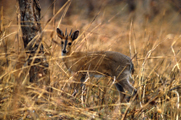 |
|
|
|
|
|
In all mountain regions we find similar habitat types and therefore we can find animals that fill the niche of the specific habitats in all the the regions. However, because the formation and colonisation histories of the regions are different, these animals are not the same species all over the world and sometimes do not even belong to the same order. |
Herbivore small mammals |
Every alpine region contains large areas of grassland. A large variability of small mammals populate these habitats. This applies to the mountain regions selected here as well as for other ranges like the Andes or the Himalaya. |
 1 1
 2 2
 3 3
 4 4
|
| 1. | Alpine marmot (Marmota marmota); European Alps (Photo: T. Jucker; 246K) |
| 2. | Common vole (Microtus arvalis); European alps (Photo: G. Lacz/SUNSET; 303K) |
| 3. | Wombat (Vombatis ursinus); Snowy Mountains of Australia (Photo: K. Green; 89K) |
| 4. | Abyssinian grass rat (Arvicanthis abyssinicus); Ethiopian Highlands (Photo: R. Güttinger; 363K) |
Large herbivore mammals |
Large herbivore mammals do not live permanently in the alpine range. They feed in the alpine grasslands and retreat into the subalpine forests where they find protection from predators. They undertake daily migrations between feeding and resting sites. |
 5 5
 6 6
 7 7
 8 8
|
| 5. | Red deer (Cervus elaphus); European Alps (Photo: T. Jucker; 222K) |
| 6. | Red-necked wallaby (Macropus rufogriseus); Snowy Mountains of Australia (Photo: K. Green; 186K) |
| 7. | Common duiker (Sylvicapra grimmia); Ethiopian Highlands (Photo: Agency SUTTER; 271K) |
| 8. | Cape eland (Taurotragus oryx); Ethiopian Highlands (Photo: Gerald and Buff Corsi © California Academy of Sciences; 159K) |
Carnivores specialising in small mammal prey |
Some small to mid-sized carnivores have spezialised in small mammal prey. What is remarkable is the striking similarity between the Semian fox from the Ethiopian highland and the Maned wolf from the Andes. |
 9 9
 10 10
 11 11
 12 12
|
| 9. | Fox (Vulpes vulpes); European Alps (Photo: T. Jucker; 243K) |
| 10. | Stoat (Mustela ermina); European Alps (Photo: K. Robin; 245K) |
| 11. | Maned wolf (Chrysocyon brachyurus); Andes (Photo: Agency SUTTER; 321K) |
| 12. | Semian fox (Canis simensis); Ethiopian Highlands (179K) |
Specialists in larger mammal prey |
The predators of larger mammals are bound less to the alpine habitat than to their prey. The large carnivores have wide home ranges and hunt in alpine regions as well as in lower mountain forests. |
 13 13
 14 14
 15 15
|
| 13. | Grey wolf (Canis lupus); European Alps (Photo: E. Dragesco/SUTTER; 192K) |
| 14. | Lynx (Lynx lynx); European Alps (Photo: K. Robin; 395K) |
| 15. | Leopard (Pantherus pardus); Ethiopian Highlands (Photo: Agency SUTTER; 247K) |
|
|
Small mammals in boulder fields |
Boulder fields are a habitat that harbour specially adapted species all over the world. Depending on the region, these species belong to very different systematic orders. The analog development of these boulder adapted species indicates that it is worthwile to adapt even to a habitat that seems at first look to be unprofitable. |
 16 16
 17 17
 18 18
 19 19
 20 20
|
| 16. | Snow vole (Microtus nivalis); European Alps (Photo: Agency SUTTER; 222K) |
| 17. | Mountain pygmy possum (Burramys parvus); Snowy Mountains of Australia (Photo: K. Green; 246K) |
| 18. | Brown antechinus (Antechinus stuartii); Snowy Mountains of Australia (Photo: K. Green; 202K) |
| 19. | Narrow headed rat (Stenocephalemys albocaudata); Ethiopian Highlands (Photo: R. Güttinger; 312K) |
| 20. | Rock hyrax (Procavia capensis); Ethiopian Highlands (Photo: Agency SUTTER; 211K) |
Rock climbers |
Rock climbers are also large herbivores but they retreat into the rocks after feeding instead of into the forest as in the case of the group of "large herbivore mammals"). |
 21 21
 22 22
 23 23
|
| 21. | Ibex (Capra ibex); European Alps (337K) |
| 22. | Chamois (Rupicapra rupicapra); European Alps (171K) |
| 23. | Gelada baboon (Theropithecus gelada); Ethiopian Highlands (Photo: M. Manni; 460K) |
|
|
The above mentioned niches have been occupied by a great variety of animals which are sometimes not related at all. But there also exist species that are closely related and look quite the same all over a continent or even around the world: |
Wild goats (Europe) |
Wild goats are common in alpine habitats because of their ability to climb rocks and their capability of living with a very sparse food supply. They are present in all European mountains but the species must have been isolated from one another long enough to have evolved peculiar morphs. |
 24 24
 25 25
 26 26
 27 27
 28 28
|
| 24. | Alpine Ibex (Capra ibex) European Alps (272K) |
| 25. | Beceite Ibex (Capra pyrenaica hispanica) Sierra Nevada (209K) |
| 26. | Caucasian Ibex (Capra cylindricornis) East Caucasus (215K) |
| 27. | Gredos ibex (Capra pyrenaica victoria) Sierra de Gredos (320K) |
| 28. | Bezoar ibex (Capra aegara) Greek Islands, Caucasus, Asia Minor (232K) |
Marmots (World) |
Marmots can be found all around the globe in the northern hemisphere. |
 29 29
 30 30
 31 31
 32 32
|
| 29. | Alpine marmot (Marmota marmota); European Alps (Photo: T. Jucker; 246K) |
| 30. | Hoary marmot (Marmota caligata); North America, Rocky Mountains to Alaska (105K) |
| 31. | Yellow-bellied marmot (Marmota flaviventris); North America, Rocky Mountains, Sierra Nevada (126K) |
| 32. | Woodchuck (Marmota monax); Non alpine parts of North America (Photo: C. Maher) |
29 August 2011 |
||
| |
||